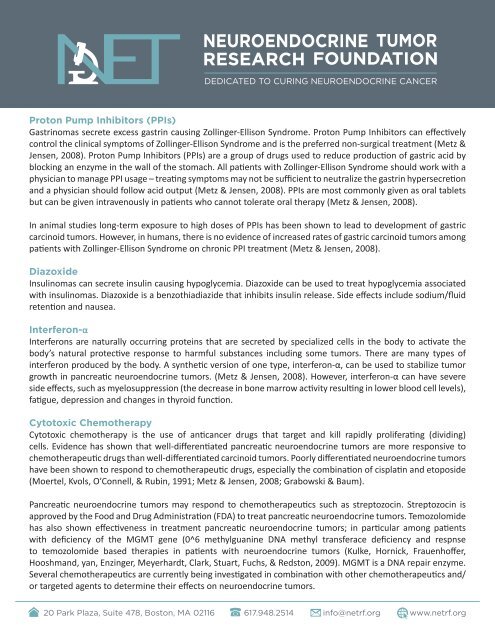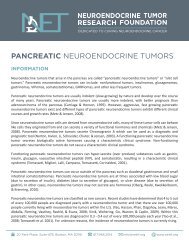PANCREATIC NEUROENDOCRINE TUMORS
You also want an ePaper? Increase the reach of your titles
YUMPU automatically turns print PDFs into web optimized ePapers that Google loves.
Proton Pump Inhibitors (PPIs)<br />
Gastrinomas secrete excess gastrin causing Zollinger-Ellison Syndrome. Proton Pump Inhibitors can effectively<br />
control the clinical symptoms of Zollinger-Ellison Syndrome and is the preferred non-surgical treatment (Metz &<br />
Jensen, 2008). Proton Pump Inhibitors (PPIs) are a group of drugs used to reduce production of gastric acid by<br />
blocking an enzyme in the wall of the stomach. All patients with Zollinger-Ellison Syndrome should work with a<br />
physician to manage PPI usage – treating symptoms may not be sufficient to neutralize the gastrin hypersecretion<br />
and a physician should follow acid output (Metz & Jensen, 2008). PPIs are most commonly given as oral tablets<br />
but can be given intravenously in patients who cannot tolerate oral therapy (Metz & Jensen, 2008).<br />
In animal studies long-term exposure to high doses of PPIs has been shown to lead to development of gastric<br />
carcinoid tumors. However, in humans, there is no evidence of increased rates of gastric carcinoid tumors among<br />
patients with Zollinger-Ellison Syndrome on chronic PPI treatment (Metz & Jensen, 2008).<br />
Diazoxide<br />
Insulinomas can secrete insulin causing hypoglycemia. Diazoxide can be used to treat hypoglycemia associated<br />
with insulinomas. Diazoxide is a benzothiadiazide that inhibits insulin release. Side effects include sodium/fluid<br />
retention and nausea.<br />
Interferon-α<br />
Interferons are naturally occurring proteins that are secreted by specialized cells in the body to activate the<br />
body’s natural protective response to harmful substances including some tumors. There are many types of<br />
interferon produced by the body. A synthetic version of one type, interferon-α, can be used to stabilize tumor<br />
growth in pancreatic neuroendocrine tumors. (Metz & Jensen, 2008). However, interferon-α can have severe<br />
side effects, such as myelosuppression (the decrease in bone marrow activity resulting in lower blood cell levels),<br />
fatigue, depression and changes in thyroid function.<br />
Cytotoxic Chemotherapy<br />
Cytotoxic chemotherapy is the use of anticancer drugs that target and kill rapidly proliferating (dividing)<br />
cells. Evidence has shown that well-differentiated pancreatic neuroendocrine tumors are more responsive to<br />
chemotherapeutic drugs than well-differentiated carcinoid tumors. Poorly differentiated neuroendocrine tumors<br />
have been shown to respond to chemotherapeutic drugs, especially the combination of cisplatin and etoposide<br />
(Moertel, Kvols, O’Connell, & Rubin, 1991; Metz & Jensen, 2008; Grabowski & Baum).<br />
Pancreatic neuroendocrine tumors may respond to chemotherapeutics such as streptozocin. Streptozocin is<br />
approved by the Food and Drug Administration (FDA) to treat pancreatic neuroendocrine tumors. Temozolomide<br />
has also shown effectiveness in treatment pancreatic neuroendocrine tumors; in particular among patients<br />
with deficiency of the MGMT gene (0^6 methylguanine DNA methyl transferace deficiency and respnse<br />
to temozolomide based therapies in patients with neuroendocrine tumors (Kulke, Hornick, Frauenhoffer,<br />
Hooshmand, yan, Enzinger, Meyerhardt, Clark, Stuart, Fuchs, & Redston, 2009). MGMT is a DNA repair enzyme.<br />
Several chemotherapeutics are currently being investigated in combination with other chemotherapeutics and/<br />
or targeted agents to determine their effects on neuroendocrine tumors.<br />
20 Park Plaza, Suite 478, Boston, MA 02116 617.948.2514 info@netrf.org www.netrf.org
















